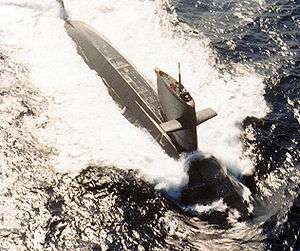Hai Lung-class submarine
 ROCS Hai Lung (SS-793) | |
| Class overview | |
|---|---|
| Name: | Chien Lung |
| Builders: | Rotterdamsche Droogdok Maatschappij |
| Operators: |
|
| Built: | 1982-1986 |
| In commission: | 1987-present |
| Planned: | 2 |
| Completed: | 2 |
| Active: | 2 |
| General characteristics | |
| Type: | Conventional attack submarine |
| Displacement: |
|
| Length: | 66.9 m (219 ft) |
| Beam: | 8.4 m (28 ft) |
| Draught: | 6.7 m (22 ft) |
| Propulsion: | 3 × Bronswerk/Stork-Werkspoor RUB 215x12 diesels; 4050 hp |
| Speed: |
|
| Test depth: | 300 m |
| Complement: | 67 (8 officers) |
| Sensors and processing systems: |
|
| Armament: |
|
The Chien Lung class of submarine, also known as the Hai Lung (Sea Dragon) class, was manufactured in the Netherlands for the Republic of China (Taiwan) and is currently in service with its navy. They are a modified version of the Dutch Navy's Zwaardvis class which itself is based on the US Barbel class.
History
Republic of China(Taiwan) orderd two submarines, based on the Dutch Zwaardvis (Swordfish) design, in September 1981.[1] The keels for both submarines were laid down by RDM (Rotterdamsche Droogdok Maatschappij) in December 1982, though initial construction of the submarines was delayed due to the builder's financial instability but work resumed in 1983. Both submarines were launched in 1986, the Hai Lung on October 6th and the Hai Hu on December 10th. Sea trials for the Hai Lung began in March 1987 and the Hai Hu commenced its trials in January 1988. Both ships were transported to Taiwan on board a heavy dock vessel. The Hai Hu was commissioned for service on October 9th, 1987 and the Hai Lung followed on April 9th, 1988.[2]
More boats in this class were planned. For example, in October 1983 the Dutch government was having talks with Taiwan for 2 extra submarines.[3] The order worth ƒ800 million was to be paid for 50% by investments of Taiwan in the Netherlands in the form of civil orders. However, the dealt fell through after Chinese pressure on the Dutch government. A order for four more boats was also turned down by the Netherlands Government in 1992 after Beijing downgraded diplomatic ties with the Dutch.[4]
Design
The Hai Lung-class submarines is based on a improved Zwaardvis-class design. This means that they also make use of the US Navy's teardrop-hull design, which was first used by the Barbel class of conventional submarines. The design was modified to include the placement of noise-producing machinery on a false deck with spring suspension for silent running.[1]
Tasks
The Hai Lung-class submarines are aimed at providing Taiwan the capability to deter Chinese naval blockades and to ensure that its sea lanes remain open, thus protecting the trade on which the island depends. In addition, both submarines could be used to block Chinese ports but are unlikely to be capable of countering Beijing's superior submarine fleet.[5]
Planned upgrade
In 2005, it was reported that the Chien Lung-class submarines would be upgraded to be capable of launching the UGM-84 Harpoon anti-ship missile.[6]The Pentagon notified the United States Congress of the sale to Taiwan of 32 UGM-84 Harpoon Block II missiles, along with two weapon control systems, other associated equipment and services, in 2008.[7] The delivery of the Harpoon anti-ship missiles started in 2013 and was completed in 2016. The upgrade allows the Hai Lung-class submarines to be able to attack targets from the sea, such as the Port of Shanghai, as well as nuclear submarines at the secret naval base in Yulin on the island of Hainan. The 32 Harpoon missiles have a range of about 125 kilometers. This is much more than the torpedo's the Republic of China Navy had before, which could only hit targets at shorter distances. The submarines can with the new missiles now attack targets both at sea and on land.[8]
Boats
| Name | Laid down | Launched | Commissioned |
|---|---|---|---|
| Sea Dragon (SS-793) | 15 December 1982 | 6 October 1986 | 9 October 1987 |
| Sea Tiger (SS-794) | December 1982 | 10 December 1986 | 9 April 1988 |
See also
References
- 1 2 Hai Lung [Sea Dragon]-class [Zwaardvis] Submarine, Global Security, retrieved 24 April 2018
- ↑ Hai Lung (class) Taiwan (1987), Military Factory, 14 August 2017, retrieved 24 April 2018
- ↑ Kabinet praat over levering van onderzeeërs aan Taiwan (in Dutch), Digibron.nl, 28 October 1983, retrieved 24 April 2018
- ↑ Jelle Brandsma (1 September 2004), 'Den Haag boort RDM orders door de neus' (in Dutch), Trouw, retrieved 24 April 2018
- ↑ Taiwan Submarine Capabilities, NTI, 23 July 2013, retrieved 24 April 2018
- ↑ "Taiwan to boost submarine force with Harpoon anti-ship missiles: Jane's". AFP. 2005-09-25. Retrieved 2007-12-23.
- ↑ "Taipei Economic and Cultural Representative Office in the United States – UGM-84L HARPOON Block II Missiles" (PDF). DSCA. 2008-10-03. Archived from the original (PDF) on 2011-05-27. Retrieved 2008-10-06.
- ↑ Stieven Ramdharie (8 January 2014), Taiwan kan China nu ook vanuit zee treffen (in Dutch), De Volkskrant, retrieved 24 April 2018
External links
- Hai Lung (Sea Dragon)-class (Zwaardvis) Submarine - Globalsecurity
- Fast-attack boat efficacy questioned - Taipei Times
- Taiwan Navy Emphasizing Domestic Shipbuilding Program in Ongoing Maritime Restructure - USNI News
- The End of the Flimsy Surface Ship Navy is Here - Combat Reform
- Taiwan seeking Aegis destroyers from U.S.: report - Reuters
- Absalon Class Littoral Support Ships - Defense Media Network
- Why Taiwan Needs Submarines - The Heritage Foundation
- Chien Lung/Hai Lung type for Taiwan - Dutch Submarines